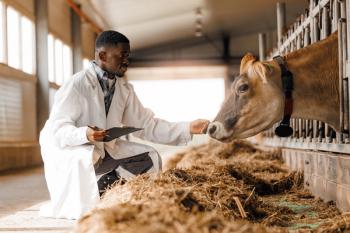
Crisis control
National Report - More than half of the deans at the nation's 28 veterinary colleges say cuts to state funding have negatively affected their ability to maintain academic programs and course offerings, according to new survey data collected by the Association of American Veterinary Colleges (AAVMC).
NATIONAL REPORT — More than half of the deans at the nation's 28 veterinary colleges say cuts to state funding have negatively affected their ability to maintain academic programs and course offerings, according to new survey data collected by the Association of American Veterinary Colleges (AAVMC).
The new data were collected last fall and released at the North American Veterinary Conference in Orlando in January.
Financial struggles for veterinary colleges and veterinary students over the past several years has been no secret. Decreased state funding and escalating costs is making it more difficult for veterinary schools to remain fully staffed. Increasing tuition rates are burdening new graduates with record amounts of student debt.
The North American Veterinary Medical Education Consortium's collaborative report dubbed the "roadmap for the future of veterinary education" was adopted by the AAVMC Board of Directors last summer. It highlighted the need for veterinary schools to graduate veterinarians with the real-world skills necessary to immediately contribute to veterinary practice.
But with decreasing resources and a call to continue to do more with less, the question now is, what will leaders in veterinary education do to reach the destination laid out by NAVMEC's roadmap?
The state of U.S. veterinary education
Not much has changed over the past few years in terms of funding for veterinary education. Despite calls for states to rescind funding cuts put in place during the recession, most of the nation's veterinary colleges continue to struggle with budget cuts.
According to AAVMC, veterinary schools across the country have faced $104 million in state cuts over the past two years alone.
"These cuts have really caused a reduction in the number of faculty at a number of colleges, many through retirement or [pursuing] opportunities at other places," says Dr. Bennie Osburn, former dean of the University of California-Davis School of Veterinary Medicine and interim executive director of AAVMC. "The money has not been there to replace these reductions, and we see them continuing for the next number of years."
Colleges of veterinary medicine are reporting that, nationally, they have been unable to fill 120 faculty positions. In a recent economic survey conducted by AAVMC, 71.4 percent of veterinary college deans said state cuts have reduced their ability to hire and maintain faculty, 53.5 percent said the cuts have affected their ability to maintain academic programs and course offerings and 50 percent said the cuts are interfering with extension and outreach services.
And veterinary education leaders aren't expecting improvement any time soon, with a large number of the nation's veterinary faculty nearing retirement age, Osburn says.
Sharing resources
As stated in the NAVMEC report, veterinary schools will increasingly have to look at sharing resources as a way to provide the same education to veterinary students, Osburn says. Many colleges are looking at—and some already have initiated—sharing faculty and courses through distance learning programs or online courses.
"There's work beginning in those areas, but as we look down the road, we're going to need more of that type of thing," Osburn says.
Some clinic areas are impacted more than others in this realm, Osburn says, like food animal and large animal programs. For example, instead of each school addressing multiple large animal species, regional centers will likely be used to save resources. Iowa has a swine center and Minnesota and California have dairy centers. Osburn says those centers could train students from other colleges that lack resources.
"There may be some of these centers that are going to continue to develop," Osburn says, adding that veterinary education leaders are working with the U.S. Department of Agriculture to facilitate such programs.
Two-plus-two programs, where students complete their first two years of a DVM program at one school and the second two years at another, also are increasing in popularity, with collaborations now in place between Nebraska and Iowa, and Washington and Utah, Osburn notes.
Figuring out the finances
The financial piece of the equation is still a big question mark when it comes to sharing resources across veterinary colleges. Osburn says the ways in which tuition and fees will be shared among colleges that offer collaborative programs is still being ironed out. But colleges do recognize the need to move forward with such programs, even without a firm plan in place.
"We need to offer what we can to the students, so, in a sense, we're just trying to find a way to accommodate them," Osburn says. "We think as we move down the road, maybe there will be ways we're going to have to be innovative and find resources."
Moving students to regional centers, as suggested for large animal and food animal studies, can cause added expense to the students, who are taken away from their homes and families, Osburn says. Colleges have found students are willing to relocate temporarily to achieve career goals, but veterinary education will have to determine how long students will be able to maintain such a lifestyle without drastically increasing their already high debt levels.
According to AAVMC, veterinary tuition climbed over the past decade, nearly doubling to today's average of $38,000 per year for out-of-state students and $18,000 for in-state students. Over the last year alone, the average tuition at veterinary colleges rose 6.6 percent, according to AAVMC. These rises are typical, according to the association. Average undergraduate tuition in all majors across the country rose 8.3 percent this year. Resident medical school tuition rose 7.7 percent.
Still, AAVMC says, financial aid provided by institutions has remained flat over the past decade, at about $3,300 annually per student. And veterinary students are now facing more than $140,000 in debt upon graduation.
Veterinary colleges are working on ways to reduce the cost of education. One method under consideration is and increasing the number of students, Osburn says.
"One of things that comes with increasing the number of students is (that) it is one way to reduce the cost of education," Osburn says. "So that reduction in cost is a way of ... taking the top off of it."
Some insiders in the veterinary profession have warned that increasing enrollment at veterinary schools for the sake of lowering tuition will only hurt new graduates who face an already saturated job market. Osburn counters that the perceived shortage of jobs in the veterinary profession is more anecdotal than real.
"When you stop and look at even American Veterinary Medical Association (AVMA) data for the past four years, there's only been a drop of about 4 percent in new graduates who have job offers when they leave school.
"In the past there have been more job offers and opportunities for graduates. Now you may have to look a little bit more," Osburn says, "but there are still jobs out there."
There are fewer choices, but Osburn adds, "I think that if you want a job, you can find one."
In terms of student debt, Osburn says AAVMC has been working for some time with AVMA on veterinary loan repayment programs for livestock practitioners, and AAVMC recently began exploring new opportunities for veterinary student funding with the National Institutes of Health and the U.S. Department of Health and Human Services. The U.S. Department of Education also has some opportunities available that veterinary students may not know about, Osburn says.
In addition to these programs, veterinary colleges are working on developing new scholarship funds, he says.
"So a wide variety of things are underway," Osburn says. "The big thing is nobody is really promoting more public support for these programs and that's where the whole infrastructure and loss of faculty is taking place."
Newsletter
From exam room tips to practice management insights, get trusted veterinary news delivered straight to your inbox—subscribe to dvm360.






